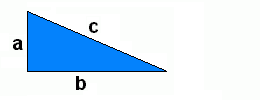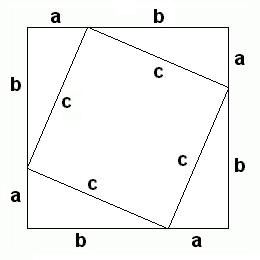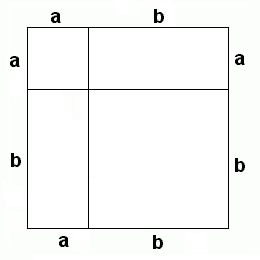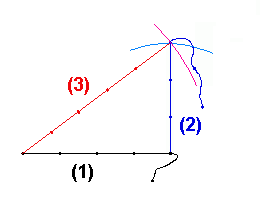Note on the Pythagorean TheoremThe Pythagorean Theorem can in fact be traced back to a Babylonian clay tablet dated ca. 1800 B.C. And whether Pythagoras (ca. 560 - ca. 480 B.C.) or one of his scholars was the first to elaborate its proof can't be claimed with any degree of credibility. Nevertheless, the geometric identity describing the relation between the length of the three sides of a right triangle is known as the Pythagorean Theorem:a2 + b2 = c2Where a and b are the lengths of the orthogonal sides and c is the length of the hypotenuse or "oblique" side of the triangle. Euclid's "Elements" (ca. 300 B.C.) was the first - and for many centuries remained the only - standard reference in Geometry. In this work Euclid supplied two very different proofs for the Pythagorean Theorem. Euclid also mentioned and proofed that the Theorem is reversible, which means that a triangle whose sides satisfy a2 + b2 = c2 is necessarily right angled. The theorem of Pythagoras is of fundamental importance in the Euclidean Geometry where it serves as a basis for the definition of distance between two points in an orthogonal grid. Mathematical PhilosophyThe earliest recorded beginnings of geometry can be traced to ancient Egypt the ancient Indus Valley, and ancient Babylonia from around 3000 BC. Early geometry was a collection of empirically discovered principles concerning lengths, angles, areas, and volumes, which were developed to meet some practical need in surveying, construction, astronomy, and various crafts. Among these were some surprisingly sophisticated principles, for example, both the Egyptians and the Babylonians were aware of versions of the Pythagorean theorem about 1500 years before Pythagoras.Pythagoras and his scholares considered Numbers to be the true nature of things and they established a religious philosophy in which mathematics played an important role. It was the Pythagoreans who discovered that the relationship between musical notes could be expressed in numerical ratios of small whole numbers. In fact they started to treat the "theory of numbers" as a new dicipline in mathematics. In elementary number theory, integers are studied without use of techniques from other mathematical fields. Questions of divisibility, greatest common divisors, factorization of integers into prime numbers, investigation of perfect numbers and congruences belong here. On the other hand the Pythagoreans realized that numbers and geometry (the study of shapes) were closely related and that geometric problems could be solved with cognition of number theory but also that questions in number theory could be geometricaly solved. These "bridges" between different mathematical diciplines is a very strong instrument to solve a difficult problem in one dicipline by translating it into another dicipline in with a solution can be elaborated more easily and then translating the solution back to the original dicipline. The bridge between numbers and geometry is the fact that sides, area or volume of physical shapes can be related to a number. The basis for this is the term "length". The length of some physical distance is defined as the number of times a (physical) reference distance (e.g. one Meter) is included in the unknown distance. The result is a number and a unit (the unit being the reference length used to obtain the number). Proof of the Phytagorean TheoremA simple (geometrical) proof of the Phytagorean theorem can be elaborated as described below. It is based on the following two "presumptions":
| ||||||||||
| Cover << Sail Away << Notes on Trigonometry << Notes on Plane Trigonometry << . | last updated: 28-Apr-2006 |



